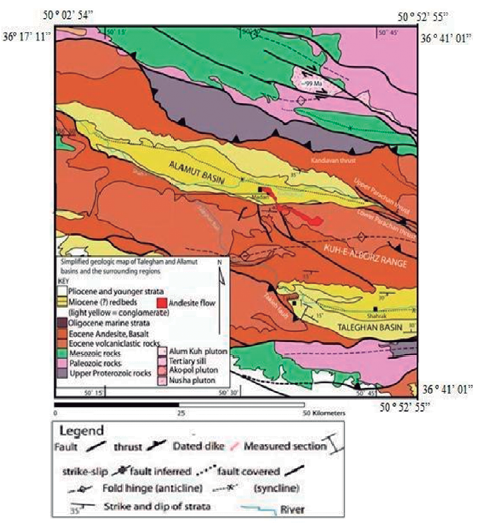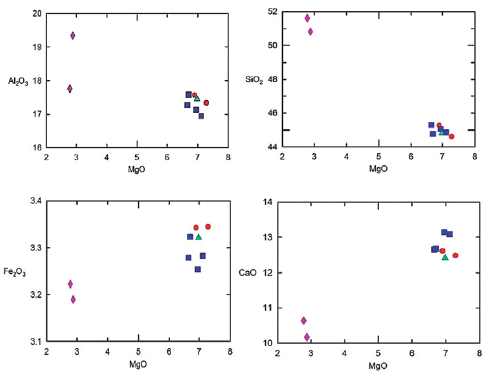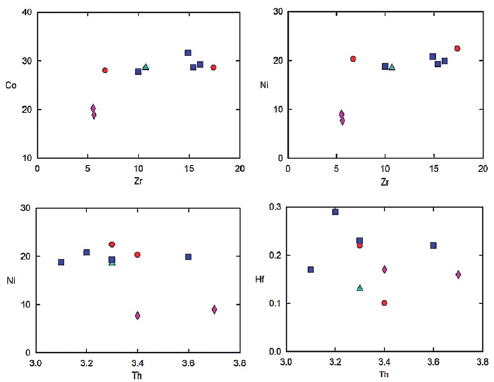Introduction
A key feature of alkaline volcanic rock compounds in the continental regions is their incompatible enrichment of elements, mainly volcanic, depending on the final stages of the active subduction zones of continental margins. These properties are transmitted to magmas that have passed through an enrichment continental crust of incompatible elements and can later be observed with contaminated crust (Wilson, 1989). Concerning the mantle origin, volcanic regions of the post-orogenic areas have been proposed in previous studies, including the continental lithosphere enriched by materials released from the oceanic plate (Lima and Nardi, 1998), asthenosphere plumes from deep areas, the mantle (Lei and Zhao, 2007) or the participation of both of them (Pearce et al. 1990; Turner et al., 1992). Tertiary mafic volcanic rocks in northern Alborz Iran are believed to be the result of subduction of Neo-Tethys (Stalder, 1971; Alavi 1996; Hasanzadeh 2004). In Eocene, due to the subduction of Neo-Tethys, a back-arc basin is formed. The crust tensional stress results in the subsidence generating the current southern Alborz (Burberry and King, 1981). The region's tensile behavior in Eocene causes the flow of high thermal magmatism influencing all Neo-Tethys subduction zones, such as East Iran and southern Alborz (other than northern Alborz and Kopet Dagh) (Vincent et al., 2005). Due to the rollback of the intrusive oceanic plate in Eocene and the removal of pressure, the melting liquid lithosphere mantle and the asthenosphere rise. This asthenosphere uplift and the thinness of the crust produce large amounts of volcanic rocks in the Eocene of Alborz. The combination of these rocks often shows rare mantle elements (Verdel, 2009). However, studies and information on the origin of these volcanic activities are pretty limited. By considering the characteristics of the origin of these magmas, the current study presents a tectonomagmatic model for these magmatic activities.
Geological setting
The study area is located in the central parts of the Alborz Mountains structural zone in Qazvin Province in Iran (Fig. 1). Alamut region is situated between 50° 02' 54" and 50° 52' 55 " as well as from 36° 17' 11" to 36° 41' 01" northern latitudes. The area is divided into two parts of Western Rudbar Alamut and Eastern Rudbar Alamut. There exist the oldest outcrops of Paleozoic rocks in the region, including chert dolomitic rocks with Zagon mica shale, sandstone, and limestone. The Mesozoic rock units include a series of dark gray shale with sandstone layers. The rock units' outcrops in the Eocene period include a series of dark volcanic rocks with basaltic to andesitic composition along with faulty fractured altered andesitic tuff and hyaloclastite breccia. An alternative collection of green tuff, tuffite, crystalline tuff, sandstone tuff, calcareous tuff, marl, shale, and lava parts with andesitic dacite to rhyodacite composition appears in the north of the Anke-Barajin trust fault (North Qazvin fault). Essential outcrops of rock units have been formed during the Neogene, from dark to brown volcanic rocks with trachyte, andesitic dacite composition, and local feldspathoid volcanic lava.
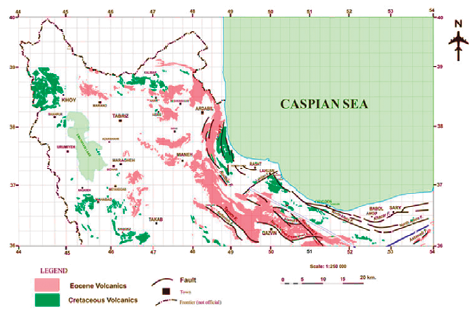
Figure 1 Map of Cretaceous and Eocene volcanic outcrops in Alborz, based on Qazvin's quadrilateral maps of Rasht.
Samples and Methods
The present study was based on field studies, petrography, and chemical analysis of main and rare elements. Field studies investigated the area of study in terms of lithology and sampling. In this regard, for the lithogeochemical studies, the macroscopic samples of volcanic rocks were selected and sent to Mashhad laboratory to produce thin sections. Ten suitable samples were sent to the ACME Laboratory in Canada to analyze the whole rock by the ICP method. Minpet, Excel, Petrography, GCDkit, and other specialized software were implemented to scrutinize the research findings. In the last stage of the research, field study, petrography, and geochemistry data were analyzed, and a comprehensive view was made on petrology, tectonics, and geochemistry status of the region.
Lithological study
According to the field and petrography studies, volcanic rocks of the region are constituted from intermediate to basic lava plus pyroclastic rocks of Eocene in a shallow marine environment with basaltic andesite, andesitic basalt, olivine basalt, and basalt composition. The dominant textures include porphyritic with microlithic matrix, porphyric with medium grain matrix, and doleritic texture. According to mineralogy, the rocks are predominantly composed of plagioclase, clinopyroxene, and olivine. The textures in plagioclase in basaltic rocks include mainly seive and glomerphyric textures. Plagioclase crystals contain polysynthetic, carlsbad, albite-pericline with defected and albitized margin. Fine olivine crystals are often subautomorph and altered into biotite, serpentine, chlorite, iron oxide, and iddingsite. The matrix comprises glass, plagioclase microliths, opaque minerals, and secondary minerals (Fig. 3).
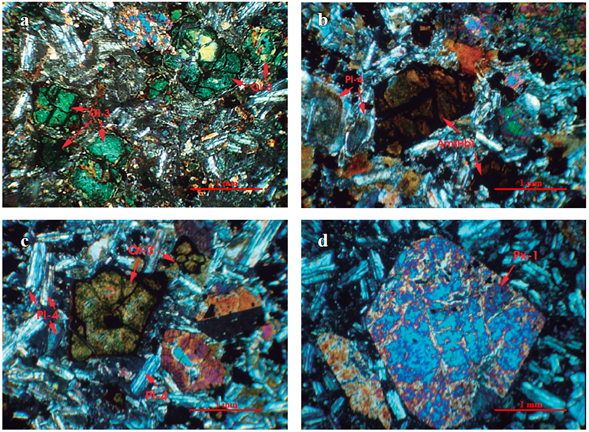
Figure 3 (a) A matrix enriched with sodic plagioclase in basalt, (b) porphyritic texture with microlithic glass matrix, chlorination of olivine in a matrix rich of sodic plagioclase in basalt, (c) porphyritic texture with microlithic glass matrix and the presence of clinopyroxene phenocrysts, (d) porphyritic texture with microlithic glass matrix, chlorinated olivine with clinopyroxene and plagioclase phenocrysts.
Geochemical analysis of volcanic rocks
The results on the major elements of volcanic rocks in the Alamut region show that these rocks include a series of basic volcanic rocks. SiO2 content in these rocks varies from 48.21 to 48.28 wt%. The rocks can be categorized into basaltic, trachybasaltic, and andesitic basaltic rocks based on the TAS diagram (Figs. 4a and b). According to the sub-alkaline and alkaline series (Irvine & Baragar, 1971), the rocks fall in the alkaline range (Figs. 4 c and d). The variations in the major elements are plotted versus MgO in Figure 5. The level of major oxides such as Al2O3 and SiO2 increases with the reduction of MgO during magmatic differentiation. At the same time, the level of major oxides such as CaO and Fe2O3 drops with the reduction of MgO. The magnesium number (Mg#) of samples varies from 30 to 45. Most samples have a high Mg# in the range of the parent magma. Two samples with an Mg# of less than 40 and a far lower level of mid-plate basalts (as those found in Hawaii) are comparable with continental flood basalts (CFB) and rift basalts (similar to those found in the Rio Grande) with low to moderate magnesium numbers lacking characteristics of primitive mantle lava (Raymond, 2002). Variation of minor elements versus Zr and Th is one of the proper approaches to characterize magmatic transformations. Zr is used in these diagrams mainly due to the very low mobility of this element during alteration (Le Roex et al., 1983; Meng et al., 2012; Talusani, 2010; Widdowson et al., 2000; Widdowson, 1991) and a wide range of variations of this element in basaltic rocks. In addition, Zr shows a completely incompatible geochemical behavior during partial melting and differential crystallization of basaltic lavas (Talusani, 2010) and tends to enter and remain in the melt phase. As seen in Figure 6, Ni is slightly scattered positive versus Zr, and Th is somewhat scattered positive versus Hf. The trends observed in these diagrams represent that the rocks in this region have nearly similar geochemical characteristics with their source magma. In addition, the crystallization process plays the main petrological role in the basaltic magma evolution in the region. However, scattering can be attributed to the frequency of mafic and plagioclase phenocrysts. For further analysis of geological processes and the original characteristics of the basaltic rocks, the normalized pattern of the average values of rare and rare earth elements in basalts was plotted versus chondrites, the primitive mantle, and depleted mid-oceanic ridge basalts and was then compared with OIB, EMORB, and NMORB patterns (Fig.7). No particular Eu anomaly is observed in a diagram normalized relative to the chondrite values. This can be attributed to the lack of plagioclase and clinopyroxene differentiation (Zeng et al., 2010) during the magma evolution of forming the rocks in the region. A negative anomaly in Nb indicates the role of magmatic contamination with continental crust in the evolution of rocks. Severe positive Pb and Ba anomaly has been reported for continental crust contamination, with the positive Sr anomaly indicating the presence of plagioclase phenocrysts in the rock. More than 10 times enrichment of light rare earth elements (LREE) in comparison with heavy rare earth elements (HREE) in most samples suggests that garnet does not enter the melt but remains in the mantle origin. As can be seen, the average value of minor elements and the rare earth elements in basalts (AVS) show a pattern between EMORB and OIB with a similar general pattern. The normalized pattern of the samples is located between EMORB and OIB; hence the source of basalts in this region is confirmed by characteristics of these two origins. Although both of them have originated from the asthenosphere mantle, they may have also been affected by the lithospheric mantle to some extent.
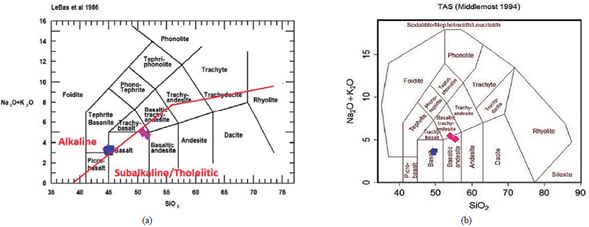
Figure 4 (a) Na2O + K2O versus SiO2 (Le Bas et al., 1986); and (b) Na2O + K2O versus SiO2 (Middlemost, 1994)
The similarity of basalts pattern in the region to ocean island basalts (OIB) rather than enriched mid-ocean ridge basalts (EMORB) can be explained by the fact that the main origin of these basalts is partially enriched asthenosphere mantle similar to the OIB origin. Despite the similarity of pattern of both groups, varieties of Alamut basalts in the elements Sr, Nb, and Zr show less enrichment than varieties of OIB. This geochemical difference can be explained by degrees of partial melting. Sometimes, the enrichment of partial melting in the rocks of the region can lead to element depletion (such as light rare earth elements) causing a lower concentration of incompatible elements and providing a lower slope of distribution for these elements as compared to OIB. An important point that needs to be taken into consideration is the high value of the Zr/Hf ratio with an average of around 60.67. According to Wever et al. (2003) and Tappa (2004), high Zr/Hf ratios reflect a residual clinopyroxene phase and lack of clinopyroxene under melting conditions. Their findings suggest that Hf with a coefficient of 1.5-2 times is more compatible than Zr in clinopyroxene mineral in the melt/clinopyroxene system.
According to the results, the mantle source of the AVS parent magma is depleted in Hf as compared with Zr, hence the high ratio of Zr/Hf could be attributed to the low degree of partial melting (Daviid et al., 2000). Therefore, it appears that besides lower partial melting which reflects the great depths of the parent mantle, the metasomatism of the parent mantle and its heterogeneity in the production of such melt can be considered as the primary source. The steep slope of HREE/LREE in the diagrams is an indicator of the presence of the garnet phase in the mantle source. In such conditions, for alkaline basalts, a deep source of garnet lherzolite with phlogopite/pargasite (mantle hornblende) at 2-2.5 GPa pressure is recommended (Thirlwall et al., 1994; Tappa 2004; Stivenson 2003; Glasser et al., 1999). From the normalized graphs of Alamut volcanic rocks based on spider diagrams, it could be concluded that due to the low K / Nb ratio and the enrichment of regional rocks with light rare earth elements (LREE) relative to heavy rare earth elements (HREE), the alkaline magma of these rocks has originated from low grade melting from a rich mantle source.
Plots of Sm/Yb versus La/Yb and La/Yb versus Dy/Yb are usually employed to detect peridotite spinel from garnet peridotite melting. In general, Yb is compatible with garnet, while La and Sm are incompatible. Accordingly, Sm/Yb and La/Yb are significantly concentrated in garnet peridotite origin at low degrees of partial melting. In contrast, during partial melting in the stability range of spinel, the La/Yb ratio is only slightly altered, but the Sm/Yb ratio remains almost unchanged (Xu et al., 2005; Yaxley, 2000; White & Mckenzi, 1995). In the diagram designed by Lai et al., (2012) based on the Sm/Yb ratio versus La / Yb, the basaltic samples of the region are located within the range of 12 to 15% of the garnet peridotite range (see Fig. 8 a and b).
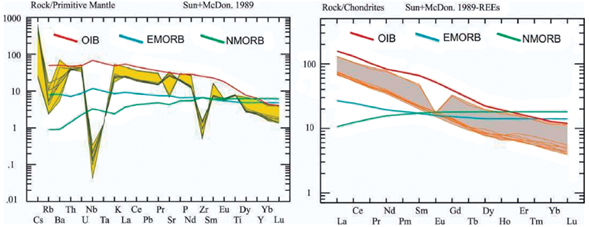
Figure 7 (a) spider diagram normalized to primitive mantle values (Sun and Mc Donough, 1989), (b) spider diagram normalized to primitive mantle values). (Wood et al., 1979), (C) spider diagram normalized to OIB (Sun and Mc Donough, 1989).
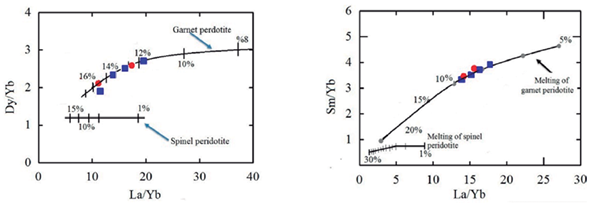
Figure 8 (a) Dy/Yb versus La/Yb from Thirlwall et al. (1994) and Bogaard et al. (2003), and (b) The logarithmic diagram of Sm/Yb versus La/Yb from Lai et al. (2012) for determining the degree of partial melting.
Table 1 Results of chemical analysis of the oxides of the main and secondary elements by the ICP of volcanic rocks in the Alamut area
| Sample | 6845 -al20 | 6846 -al10 | 6847 -al30 | 6848 -al40 | 6849 -al16 | 6850 -al50 | 6851 -al28 | 6852 -al51 | 6853 -al17B |
|---|---|---|---|---|---|---|---|---|---|
| SiO2 | 50.82 | 44.77 | 44.80 | 44.61 | 45.26 | 44.85 | 45.29 | 45.05 | 51.62 |
| Al203 | 19.35 | 17.58 | 3.34 | 17.34 | 17.56 | 16.95 | 17.28 | 17.12 | 17.77 |
| Fe2O3 | 3.19 | 3.33 | 3.33 | 3.34 | 3.34 | 3.28 | 3.28 | 3.26 | 3.22 |
| Feo | 6.16 | 9.31 | 9.20 | 9.07 | 8.54 | 9.12 | 9.13 | 9.03 | 6.82 |
| MgO | 2.88 | 6.71 | 6.98 | 7.29 | 6.90 | 7.12 | 6.66 | 6.95 | 2.77 |
| CaO | 10.17 | 12.67 | 12.43 | 12.49 | 12.62 | 13.08 | 12.65 | 13.15 | 10.64 |
| Na2O | 3.42 | 2.56 | 2.89 | 2.67 | 2.62 | 2.44 | 2.65 | 2.21 | 3.12 |
| K20 | 1.63 | 0.69 | 0.54 | 0.67 | 0.74 | 0.79 | 0.72 | 0.873 | 1.61 |
| TiO2 | 1.61 | 1.75 | 1.75 | 1.77 | 1.77 | 1.70 | 1.70 | 1.69 | 1.617 |
| P2O5 | 0.66 | 0.45 | 0.44 | 0.41 | 0.45 | 0.42 | 0.41 | 0.41 | 0.65 |
| MnO | 0.14 | 0.22 | 0.26 | 0.28 | 0.22 | 0.21 | 0.19 | 0.21 | 0.14 |
| Cr2O3 | 0.009 | 0.009 | 0.009 | 0.11 | 0.009 | 0.01 | 0.022 | 0.03 | 0.024 |
| sum | 99.23 | 99.37 | 85.26 | 99.3 | 99.4 | 99.3 | 99.3 | 99.3 | 99.187 |
| K | 13500.75 | 5779.50 | 4449.60 | 5518.14 | 6127.06 | 6637.12 | 6000.18 | 7249.21 | 13331.13 |
| P | 2857.77 | 1933.72 | 1880.75 | 1749.98 | 1932.86 | 1836.64 | 1783.11 | 1769.59 | 2803.66 |
| TI | 9623.3 | 10434.5 | 10459.2 | 10563.5 | 10556.3 | 10217.0 | 10236.3 | 10158.7 | 9691.61 |
| Mo | 1.02 | 0.95 | 0.85 | 0.74 | 0.55 | 1.01 | 0.85 | 1.02 | 1.23 |
| Cu | 112.2 | 90.74 | 158.44 | 71.86 | 198.36 | 133.59 | 89.67 | 103.34 | 172.03 |
| Zn | 101.8 | 69.7 | 71.5 | 73.3 | 70 | 62.8 | 63.8 | 70 | 82.4 |
| Ag | 34 | 30 | 54 | 21 | 75 | 41 | 39 | 39 | 59 |
| Ni | 7.7 | 19.9 | 18.5 | 7.7 | 19.9 | 18.5 | 7.7 | 19.9 | 18.5 |
| Co | 18.9 | 29.2 | 28.6 | 28.6 | 28 | 27.8 | 28.7 | 31.6 | 20.2 |
| Mn | 850 | 1028 | 1359 | 1486 | 953 | 971 | 951 | 1009 | 904 |
| Fe | 5.59 | 6.29 | 6.67 | 6.01 | 6.04 | 5.92 | 6 | 6.34 | 6.01 |
| As | 1.1 | 0.3 | 0.8 | 0.7 | 1.4 | 1.4 | 0.8 | 1.2 | 0.9 |
| U | 0.9 | 1.1 | 0.8 | 0.9 | 0.9 | 0.8 | U | 0.9 | 1.1 |
| Au | 3 | 1.4 | 0.6 | 0.8 | 0.9 | Au | 3 | 1.4 | 0.6 |
| Th | 3.4 | 3.6 | 3.3 | 3.3 | 3.4 | 3.1 | 3.3 | 3.2 | 3.7 |
| Sr | 168.1 | 559.5 | 533 | 536.6 | 537.7 | 588.3 | 714.8 | 655.9 | 142.6 |
| Cd | 0.01 | 0.03 | 0.03 | 0.03 | 0.02 | 0.02 | 0.01 | 0.01 | 0.03 |
| Sb | 0.37 | 0.11 | 0.1 | 0.13 | 0.08 | 0.12 | 0.05 | 0.08 | 0.19 |
| Bi | 0.02 | 0.02 | 0.02 | 0.02 | 0.02 | 0.02 | 0.02 | 0.02 | 0.02 |
| V | 186 | 204 | 233 | 222 | 211 | 190 | 198 | 205 | 185 |
| Ca | 3.44 | 3.56 | 3.52 | 2.96 | 3.44 | 3.67 | 3.5 | 4.02 | 4.09 |
| La | 30.6 | 17.8 | 17.2 | 16.4 | 17.6 | 16.2 | 16.6 | 16 | 31 |
| Cr | 16.6 | 30.3 | 38.3 | 65.4 | 37.2 | 34.2 | 35.6 | 44.2 | 17.1 |
| Mg | 1.32 | 1.84 | 1.96 | 1.86 | 1.88 | 1.95 | 1.81 | 2.01 | 1.37 |
| Ba | 52.4 | 131.6 | 151 | 109.5 | 306.8 | 107.7 | 491.3 | 155 | 37.6 |
| B | 20 | 20 | 20 | 20 | 20 | 20 | 20 | 20 | 20 |
| Al | 3.07 | 6.73 | 6.8 | 6.34 | 6.58 | 6.31 | 6.85 | 6.63 | 2.59 |
| Na | 0.419 | 1.388 | 1.592 | 1.473 | 1.418 | 1.323 | 1.565 | 1.178 | 0.34 |
| W | 0.07 | 0.51 | 0.05 | 0.12 | 0.05 | 0.11 | 0.13 | 0.17 | 0.07 |
| Sc | 14.9 | 3.9 | 3.7 | 3.8 | 4 | 3.9 | 3.8 | 3.5 | 16.6 |
| S | 0.02 | 0.02 | 0.02 | 0.02 | 0.02 | 0.02 | 0.02 | 0.02 | 0.02 |
| Tl | 0.02 | 0.02 | 0.02 | 0.03 | 0.02 | 0.05 | 0.03 | 0.06 | 0.02 |
| Hg | 10 | 6 | 5 | 11 | 12 | 5 | 9 | 10 | 5 |
| Se | 0.2 | 0.1 | 0.1 | 0.2 | 0.1 | 0.1 | 0.2 | 0.2 | 0.1 |
| Te | 0.02 | 0.02 | 0.02 | 0.02 | 0.02 | 0.02 | 0.02 | 0.02 | 0.02 |
| Ga | 9.4 | 12.3 | 12.8 | 12.2 | 12.5 | 11.6 | 12 | 12.3 | 8.8 |
| Cs | 0.21 | 3.28 | 5.03 | 4.31 | 4.06 | 4.05 | 3.97 | 2.99 | 0.18 |
| Ge | 0.2 | 0.1 | 0.1 | 0.1 | 0.1 | 0.1 | 0.1 | 0.1 | 0.2 |
| Hf | 0.17 | 0.22 | 0.13 | 0.22 | 0.1 | 0.17 | 0.23 | 0.29 | 0.16 |
| Nb | 0.07 | 0.16 | 0.09 | 0.14 | 0.03 | 0.1 | 0.1 | 0.24 | 0.07 |
| Rb | 1.6 | 2.6 | 3.5 | 3.3 | 3.3 | 6.5 | 6.9 | 10.6 | 1.5 |
| Sn | 1.4 | 1 | 0.9 | 0.8 | 0.7 | 0.8 | 0.9 | 0.8 | 1.5 |
| Ta | 0.05 | 0.05 | 0.05 | 0.05 | 0.05 | 0.05 | 0.05 | 0.05 | 0.05 |
| Zr | 5.6 | 16.1 | 10.7 | 17.4 | 6.7 | 10 | 15.4 | 14.9 | 5.5 |
| Y | 24.66 | 11.67 | 10.42 | 10.56 | 12.11 | 11 | 11.16 | 11.05 | 26.25 |
| Ce | 64 | 36.6 | 35.2 | 33.1 | 36.3 | 33.9 | 33.3 | 33.6 | 64.9 |
| In | 0.07 | 0.02 | 0.02 | 0.02 | 0.02 | 0.02 | 0.02 | 0.02 | 0.04 |
| Re | 1 | 1 | 1 | 1 | 1 | 1 | 1 | 1 | 1 |
| Be | 1.4 | 1.4 | 1.5 | 1.2 | 0.8 | 0.9 | 1.1 | 1.4 | 1.1 |
| Li | 5.7 | 25.7 | 37.9 | 33.2 | 37.6 | 22.5 | 25.1 | 17 | 6 |
| Pr | 7.97 | 4.3 | 4.23 | 4.01 | 4.64 | 4.07 | 4.2 | 4.22 | 8.53 |
| Nd | 35.41 | 18.02 | 17.16 | 16.11 | 18.54 | 17.59 | 16.94 | 16.95 | 36.56 |
| Sm | 7.38 | 3.25 | 3.31 | 3.04 | 3.44 | 3.24 | 3.42 | 3.25 | 7.06 |
| Eu | 0.99 | 0.95 | 0.95 | 0.88 | 1.06 | 0.95 | 1.02 | 0.96 | 1.01 |
| Gd | 6.5 | 2.98 | 2.68 | 2.41 | 2.92 | 2.83 | 2.71 | 2.86 | 6.79 |
| Yb | 1.94 | 1.09 | 0.81 | 1 | 0.92 | 0.89 | 0.84 | 0.77 | 2.07 |
| Er | 2.59 | 1.38 | 1.08 | 1.1 | 1.25 | 1.16 | 1.03 | 1.06 | 2.63 |
| Lu | 0.29 | 0.14 | 0.11 | 0.12 | 0.13 | 0.1 | 0.11 | 0.1 | 0.28 |
| Pd | 10 | 10 | 10 | 10 | 10 | 10 | 10 | 10 | 10 |
| Pt | 2 | 2 | 2 | 2 | 2 | 2 | 2 | ||
| Pb207 | 1.32 | 0.97 | 0.77 | 0.78 | 0.9 | 0.9 | 0.86 | 0.78 | 1.41 |
| Pb208 | 3.3 | 2.42 | 1.88 | 1.93 | 2.28 | 2.24 | 2.14 | 1.94 | 3.47 |
| Pb204 | 0.08 | 0.06 | 0.05 | 0.05 | 0.06 | 0.06 | 0.05 | 0.05 | 0.09 |
| ZR/HF | 32.94 | 73.18 | 82.30 | 79.09 | 67 | 58.82 | 66.95 | 51.37 | 34.37 |
A variety of graphs have been implemented to determine the tectonic setting of the magma-forming rocks in the region. In the Ta/Hf versus Th/Hf diagram (Wang et al., 2001), the basalts in the study area fall within the range of extensional or primary rift environments. The alkaline properties of these rocks confirm their formation environment (Fig. 9-a). In the Ti/Y versus Zr/Y diagram (Pearce and Gale, 1977), the samples have been situated within the continental and continental margin ranges (Fig. 9 -b). Finally, in the V versus Ti/1000 (Schervais, 1982) and Nb/Yb versus TiO2/Yb diagrams, the samples are located in the OIB and alkali basalt ranges (Fig. 9).
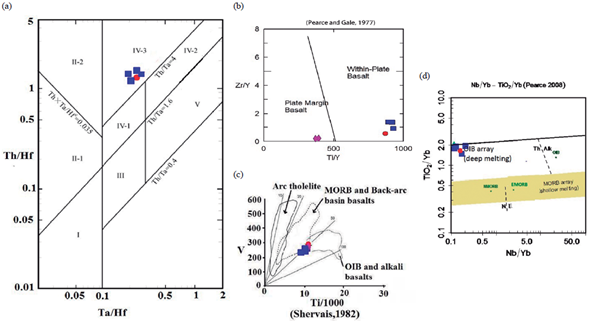
Figure 9 (a) Ta/Hf versus Th/Hf (Wang et al., 2001), (b) Ti/Y versus Zr/Y (Pearce and Gale, 1977), (c) V versus Ti/1000 (Schervais, 1982) and (d) Nb/Yb versus TiO2/Yb (Pearce, 2008)
Stratigraphic and structural studies by Allen et al. (2003) indicate that AMA volcanoclastic deposits have been formed during an extensional phase in the early Eocene. Asiabanha and Foden (2012) suggested that this extension occurred in a back-arc environment. Due to the basin uplift during the stress regime in the late Eocene, the next volcanic phase has occurred in the sub-aerial phase form. According to the results, the following model can be used for the Eocene-Oligocene magmatic activity in the study area. This model is similar to the one proposed by Humphreys et al. (2003) for West America, which consists of four steps:
In the first stage, the steep oceanic crust subduction led to the formation of a volcanic arc in the north of the Arabian-Eurasia structural zone (Fig. 10-a). In the second stage, after the Aptian-Albian orogeny phase, the subduction continued with a lower slope causing magmatic activity in the north of Central Iran and Alborz. At the end ofthe Cretaceous period, some tectonic contractions occurred from Iran to the north of this structural zone. At this stage, upper mantle uplift occurred in Alborz and northern Iran mountains (Zaeimnin et al., 2011; Haghnazar, 2012; Haghnazar et al., 2015).
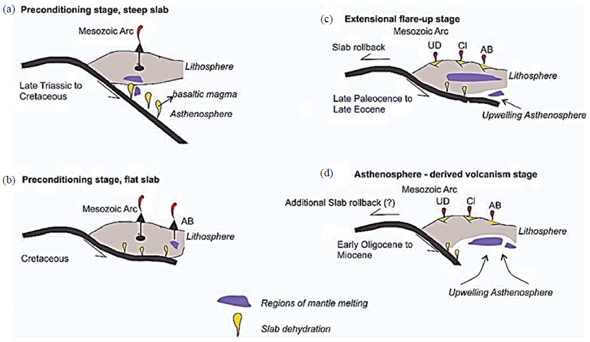
Figure 10 A view of evolution in the structural zones of Iran from late Triassic to Miocene UD= Urumieh-Dokhtar, CI=Central Iran, AB = Central Alborz, (A) Subduction of the oceanic crust in the upper Triassic to the Cretaceous along with the formation of volcanic arcs, (B) large-angle subduction is converted to flat subduction and local magmatism in the Alborz, (C) rollback of the subducted slab in the upper Paleocene and lower Eocene caused partial melting of the asthenosphere and uplift of asthenosphere and lithospheric window, (D) Continued extension in Oligocene to Miocene and formation of Qom formation (Verdel et al., 2011).
In the third stage (Eocene period), the rollback occurred in the oceanic crust. This phenomenon could be attributed to a number of factors including the rate of subduction, age of the sheet, the density difference between the plate and mantle, etc. (Heuret and Lallemand, 2005; Arfania, 2018). This results in the extension and thinning of the crust and uplift of the asthenosphere. Partial melting of hydrated peridotite occurred in the mantle due to pressure and heat reduction. The magma resulting from this melting was depleted in HFSE elements and was at the same time enriched with some other elements during the subduction caused by dehydration. At this stage, volcanic activities and shallow sea sediments formed in extensional environments (Figs. 10-c).
In the fourth stage (the beginning of the Oligocene), asthenosphere uplifting occurred due to the lithosphere thinning. At this time, the partial melting in the asthenosphere led to the formation of basaltic magma in the extensional basins. (Fig.10-d). these basaltic magmas were less contaminated due to crust thinning and mostly present the primary magma properties. (Plank and Langmuir, 1988; Glazner and Ussler, 1989; Ebrahimi et al, 2017).
Conclusion
According to the studies, the rock units in the area are divided into volcanic lavas and pyroclastic rocks. Volcanic lavas contain basalt, olivine basalt, andesitic basalt and basaltic andesite. In terms of chemical composition, the magma forming volcanic rocks in the Alamut region is alkaline. The normalized diagrams indicate that the basaltic rocks of the region are partially enriched with the asthenosphere mantle similar to the source of OIB with a partial melting degree of 12 to 15 and garnet lherzolite composition. Based on the graphical analysis and structural geology studies, the formation of rocks in the Alamut region has been related to the magmatism of continental rift zones. As a result of the deep faults, crust thinning, asthenosphere uplifting, local fractures formation by extensional phases (rifting), and partial melting in the asthenosphere, basaltic magma has formed in the extensional basin, which is less contaminated due to the crust thinning. The resulting basaltic magma presents mainly the characteristics of the primary magma. The volcanisms of AVS are linear along these local extensional faults.













